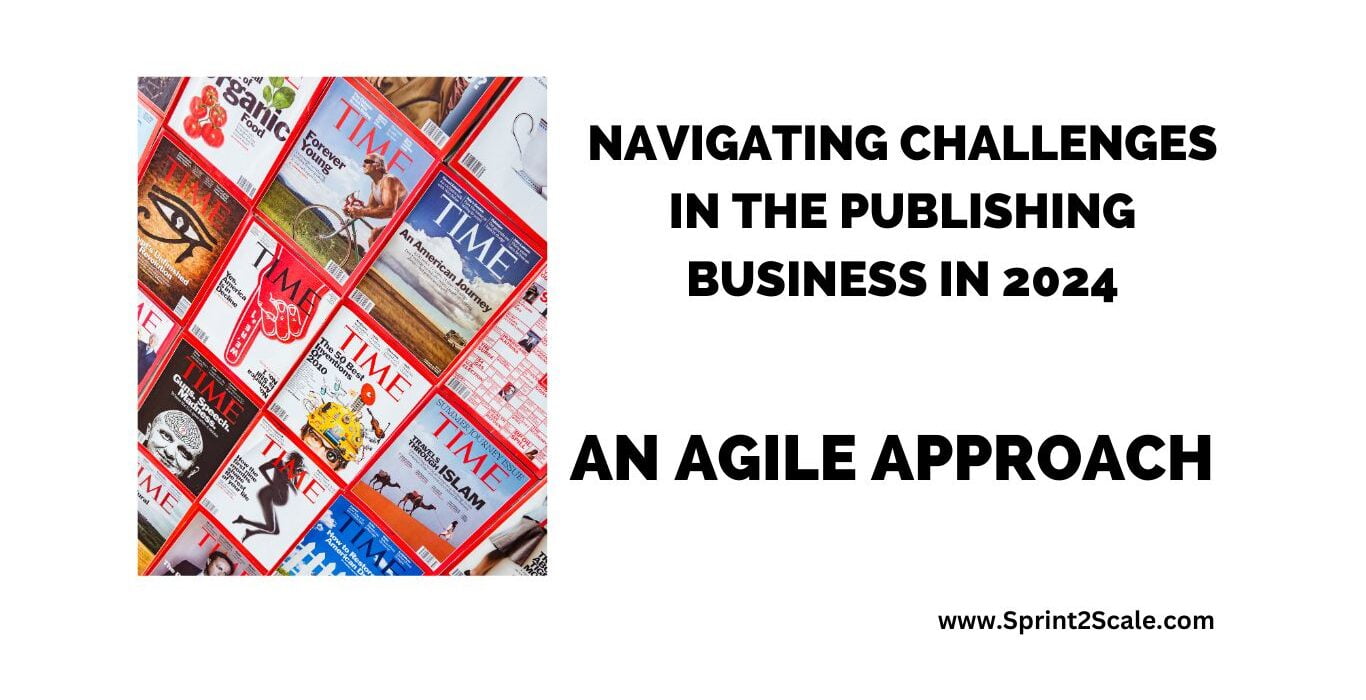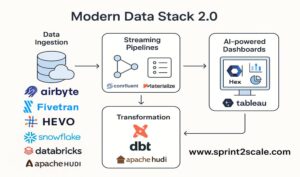The publishing industry has undergone significant transformations in recent years, with 2024 bringing its own set of challenges and opportunities. In this blog post, we’ll explore the key challenges faced by organizations in the publishing business and delve into how the agile methodology can serve as a strategic solution.
Section I: Evolving Consumer Preferences
A. Shift to Digital Platforms:
- Rise of e-books and audiobooks: In 2024, the consumption of digital content continues to surge, with e-books and audiobooks gaining immense popularity. Readers, especially those from younger demographics, are increasingly gravitating towards the convenience and accessibility offered by digital formats. Publishers face the challenge of not only adapting their content for digital platforms but also redefining their distribution strategies to meet the evolving demands of readers.
- Changing reading habits among younger demographics: The reading habits of younger generations are undergoing a transformation. With an array of digital distractions, publishers must understand and cater to the preferences of this demographic. This involves not just delivering content through digital channels but also embracing innovative formats and interactive elements that resonate with the tech-savvy readers of 2024.
B. Content Accessibility:
- The demand for multi-platform content: Readers today expect a seamless transition between different platforms. Whether they start reading on a tablet during their commute, switch to a smartphone during lunch, and then resume on a laptop in the evening, the demand for multi-platform accessibility is high. Publishers must ensure that their content is not only available across various devices but also optimized for each platform, offering a consistent and enjoyable reading experience.
- Personalized reading experiences: Readers are increasingly drawn to personalized experiences. This goes beyond recommending books based on past purchases; readers expect content tailored to their preferences, interests, and even reading speed. Publishers face the challenge of harnessing data analytics and artificial intelligence to deliver highly personalized reading recommendations and experiences, creating a deeper connection between the reader and the content.
In summary, the significant impact of evolving consumer preferences on the publishing industry in 2024. Publishers must adapt to the rise of digital formats, address the changing reading habits of younger demographics, and meet the demands for multi-platform accessibility and personalized experiences to stay relevant in an ever-changing landscape.
Section II: Technological Disruptions
A. AI and Machine Learning:
- Automation in content creation and editing: In 2024, the integration of Artificial Intelligence (AI) and Machine Learning (ML) has become increasingly prevalent in the publishing industry. Automated tools are revolutionizing content creation and editing processes. AI-driven algorithms can analyze data trends to predict what content will resonate with specific audiences, helping publishers tailor their offerings. Moreover, AI tools can assist in automated editing, improving efficiency and reducing human workload.
- Enhanced recommendation systems: AI-powered recommendation systems have evolved to offer more sophisticated and accurate suggestions to readers. These systems analyze vast amounts of data, including user preferences, reading history, and market trends, to provide personalized book recommendations. This not only enhances the user experience but also presents publishers with opportunities to target specific demographics and refine their marketing strategies.
B. Blockchain in Publishing:
- Addressing copyright and piracy issues: The integration of blockchain technology is addressing long-standing challenges related to copyright infringement and piracy. Blockchain provides a secure and transparent way to manage intellectual property rights. Smart contracts on blockchain platforms enable automated royalty payments, reducing disputes and ensuring that authors receive fair compensation for their work. This enhances trust within the publishing ecosystem and protects the rights of content creators.
- Ensuring transparency in royalty payments: Blockchain’s decentralized nature ensures transparency in financial transactions. For authors and publishers, this means a clear and traceable record of royalty payments. Blockchain eliminates intermediaries, streamlining the payment process and reducing the likelihood of errors or disputes. This technology instills confidence among authors, encouraging them to collaborate with publishers who leverage blockchain for transparent and fair compensation practices.
In summary, the technological disruptions such as AI and machine learning are transforming content creation, editing, and personalized recommendations, while blockchain is addressing issues of copyright, piracy, and ensuring transparent royalty payments. These technological advancements not only streamline processes but also foster a more secure and efficient publishing ecosystem.
Section III: Content Monetization Challenges
A. Adapting to Subscription Models:
- Challenges in transitioning from traditional sales: The publishing industry is witnessing a shift from traditional one-time purchases to subscription-based models. This transition poses challenges as publishers need to adjust their revenue models and find a balance between attracting new subscribers and retaining existing ones. Navigating this change involves reevaluating pricing strategies, understanding consumer expectations, and effectively communicating the value proposition of subscription services.
- Retaining subscribers and managing churn: Subscriber retention becomes a critical aspect of the monetization strategy. In a subscription-based model, keeping readers engaged and preventing churn is paramount. Publishers face the challenge of continuously delivering high-value content, implementing targeted marketing campaigns, and leveraging data analytics to understand subscriber behavior. Effective customer relationship management becomes key to building long-term loyalty and reducing churn rates.
B. Leveraging Data for Revenue:
- Utilizing reader analytics for targeted advertising: In 2024, publishers are increasingly relying on data analytics to understand reader preferences and behaviors. This data is not only valuable for enhancing content recommendations but also for targeted advertising. Publishers face the challenge of finding the right balance between leveraging reader data for personalized advertising without compromising user privacy. Ethical and transparent data practices are essential to build trust and compliance with evolving data protection regulations.
- Balancing data-driven strategies with privacy concerns: The rise of data-driven monetization strategies brings forth concerns related to user privacy. Publishers must navigate this challenge by implementing robust data protection measures, obtaining user consent, and being transparent about how data is used. Striking a balance between leveraging valuable reader insights for revenue generation and respecting privacy rights is crucial for maintaining trust and compliance with evolving data protection regulations.
The shift to subscription models requires adaptation in revenue strategies, emphasizing subscriber retention and effective communication of value. Simultaneously, leveraging reader data for targeted advertising necessitates a delicate balance between revenue generation and respecting user privacy concerns. Addressing these challenges is crucial for publishers aiming to thrive in the evolving landscape of content consumption.
Section IV: Accelerating Time-to-Market
A. Agile in Editorial Processes:
- Iterative writing and editing cycles: Agile methodologies bring a paradigm shift in the editorial processes of the publishing industry. Traditional linear writing and editing workflows are replaced with iterative cycles. Authors, editors, and other stakeholders collaborate in short, focused bursts, allowing for rapid feedback and continuous improvement. This iterative approach not only accelerates the production timeline but also enhances the overall quality of the content through constant refinement.
- Real-time collaboration tools for remote teams: With the increasing prevalence of remote work in 2024, agile practices leverage real-time collaboration tools to facilitate seamless communication among distributed teams. Cloud-based platforms enable authors, editors, and other contributors to work concurrently on the same document, fostering collaboration and reducing the delays associated with traditional file-sharing methods. This adaptability is especially crucial for maintaining efficiency in an industry where collaborative efforts are integral to the creative process.
B. Streamlining Production Workflows:
- Agile methodologies in layout and design: The adoption of agile extends beyond editorial processes into the design and layout phase. Agile principles, such as sprint planning and regular review sessions, are applied to streamline production workflows. Design teams work iteratively, incorporating feedback from stakeholders to ensure that the final product aligns with both creative vision and market expectations. This iterative design approach minimizes the risk of costly revisions later in the production cycle.
- Rapid prototyping for cover designs and illustrations: Agile methodologies promote the use of rapid prototyping techniques for cover designs and illustrations. Designers create and test prototypes quickly, allowing for immediate feedback and adjustments. This agile approach not only accelerates the design phase but also ensures that visual elements resonate with the target audience. The ability to iterate rapidly on cover designs is particularly valuable in a market where visual appeal plays a significant role in attracting readers.
In summary, the role of agile methodologies in accelerating time-to-market for the publishing industry in 2024. From iterative writing and editing cycles to real-time collaboration tools for remote teams, and from applying agile principles in layout and design to adopting rapid prototyping techniques, these practices empower publishers to navigate the challenges of a fast-paced and dynamic landscape while delivering high-quality content to their audiences.
Section V: Collaboration and Communication
A. Breaking Down Silos:
- Cross-functional teams for end-to-end publishing processes: In 2024, the publishing industry recognizes the importance of breaking down traditional silos that separate departments and hinder collaboration. Agile methodologies advocate for cross-functional teams that include members from different disciplines, such as editorial, design, marketing, and IT. This approach ensures a holistic and streamlined approach to end-to-end publishing processes, fostering collaboration and reducing bottlenecks associated with compartmentalized workflows.
- Improving communication between authors, editors, and marketing teams: Effective communication is at the core of successful publishing endeavors. Agile methodologies promote regular communication channels, encouraging authors, editors, and marketing teams to collaborate seamlessly. Daily stand-up meetings provide a platform for quick updates, issue resolution, and alignment of goals. This constant communication enhances understanding among team members, mitigates misunderstandings, and ensures that everyone is working towards shared objectives.
B. Agile Ceremonies in Publishing:
- Stand-ups for daily progress updates: Daily stand-up meetings, a fundamental agile ceremony, have found their place in the publishing industry. Authors, editors, designers, and other stakeholders gather for brief, focused meetings to discuss progress, challenges, and upcoming tasks. This daily check-in not only keeps everyone informed but also promotes accountability and quick issue resolution, ensuring that the project stays on track and potential roadblocks are addressed promptly.
- Retrospectives for continuous improvement: Retrospectives are another agile ceremony that publishers find valuable for fostering continuous improvement. After the completion of a project or a defined period, teams gather to reflect on what went well, what could be improved, and how to implement those improvements in future projects. This reflective practice instills a culture of learning and adaptability, allowing publishing teams to evolve and enhance their processes over time.
In summary, Section V emphasizes the critical role of collaboration and communication in the publishing industry in 2024. Breaking down silos through cross-functional teams and improving communication channels among authors, editors, and marketing teams are essential aspects of agile methodologies. The incorporation of agile ceremonies like daily stand-ups and retrospectives further enhances teamwork, accountability, and a culture of continuous improvement within publishing organizations.
Section VI: Adapting to Market Feedback
A. Agile’s Customer-Centric Approach:
- Engaging readers for early feedback: Agile methodologies emphasize the importance of involving customers, or in the case of publishing, readers, throughout the development process. Publishers in 2024 actively seek early feedback from readers during the writing and editing stages. This customer-centric approach ensures that the final product aligns with readers’ expectations and preferences. Publishers leverage various channels, including social media, surveys, and focus groups, to engage with readers and incorporate their insights into the creative process.
- Rapid iterations based on market responses: Agile principles promote rapid iterations based on continuous feedback. In the publishing industry, this means that as soon as a portion of the content is ready, publishers release it to the market for early access or limited distribution. This allows them to gather real-world feedback quickly. Subsequent iterations can then be made based on market responses, ensuring that the final product is not only well-received but also tailored to the actual needs and preferences of the target audience.
B. Experimentation and Innovation:
- Encouraging a culture of continuous improvement: Agile methodologies foster a culture of continuous improvement within publishing organizations. This involves encouraging teams to experiment with new ideas, technologies, and approaches. Whether it’s trying out a different writing style, exploring innovative marketing strategies, or experimenting with new distribution channels, the goal is to constantly evolve and refine processes for better outcomes.
- Embracing failure as a learning opportunity: In an agile environment, failure is seen as an inherent part of the learning process. Publishing teams are encouraged to take calculated risks and try innovative approaches. If a particular strategy or experiment doesn’t yield the expected results, it is viewed as a learning opportunity rather than a setback. This mindset promotes resilience, adaptability, and a willingness to embrace change in response to market dynamics.
In summary, agile methodologies guide the publishing industry in adapting to market feedback in 2024. Engaging readers for early feedback, rapid iterations based on market responses, fostering a culture of continuous improvement, and embracing failure as a learning opportunity are key aspects. By incorporating these agile principles, publishing organizations can ensure that their products resonate with their audience, stay ahead of market trends, and foster a culture of innovation and adaptability.
Conclusion
In the dynamic landscape of the publishing industry in 2024, organizations are grappling with multifaceted challenges. Agile methodologies offer a promising solution by fostering adaptability, collaboration, and a customer-centric approach. By embracing agile principles in editorial processes, production workflows, and market strategies, publishing businesses can navigate the evolving landscape with resilience and innovation, ensuring they remain at the forefront of the industry.







No Comment! Be the first one.